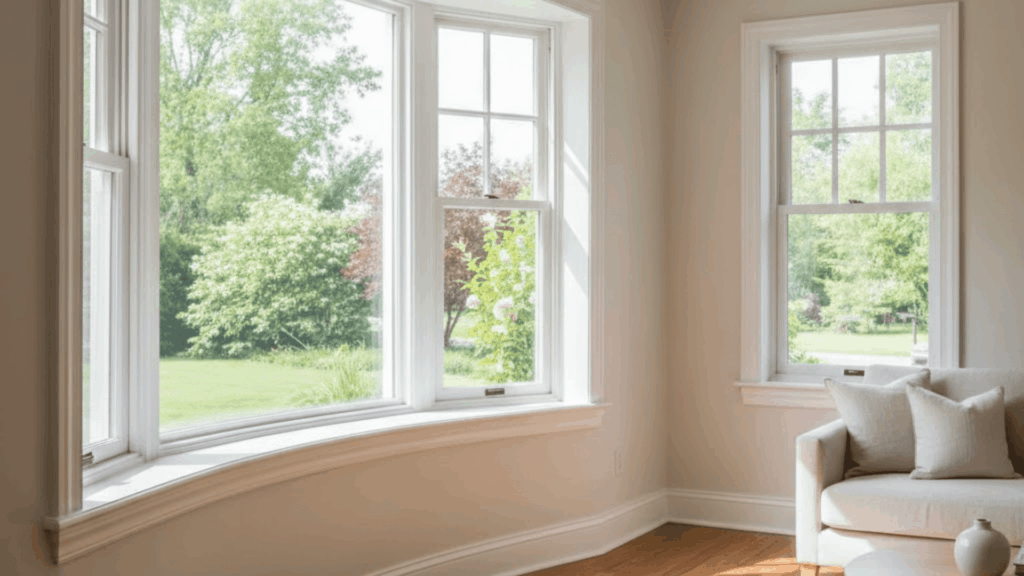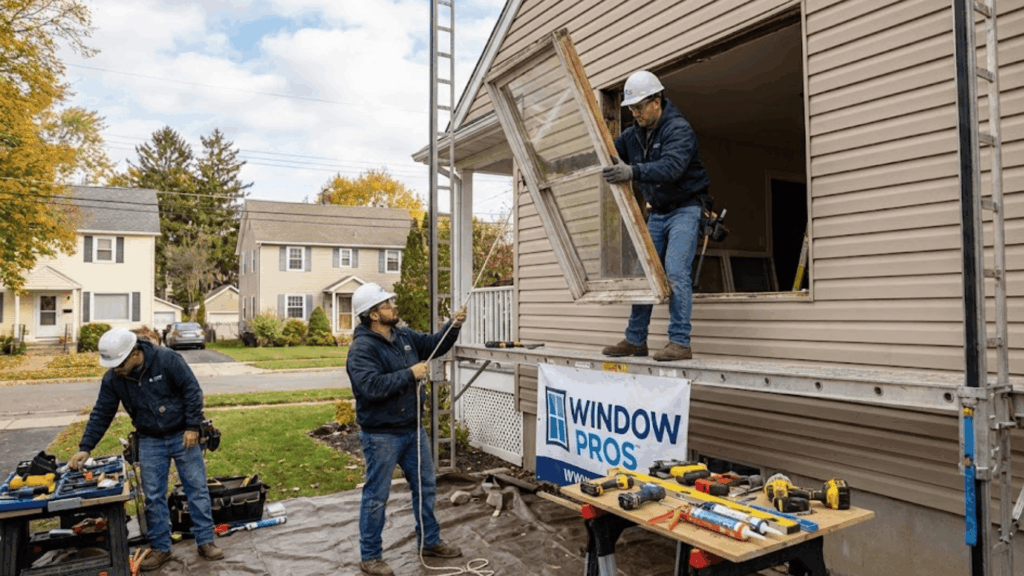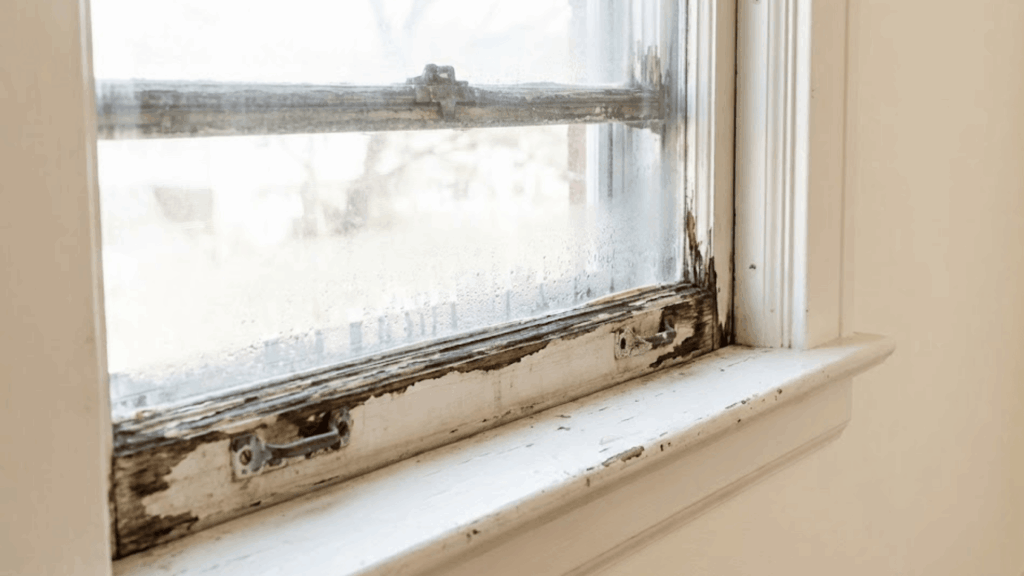One day, I finally decided to replace my old, drafty windows. The moment I started researching, I realized window installation isn’t just about picking pretty frames.
It’s an investment that touches everything from your energy bills to your home’s curb appeal.
If you’re standing where I once stood, wondering what this project will actually cost and what you’re paying for beyond the glass itself, you’re in the right place.
I’ve learned that understanding the full scope of materials, labor, and all those hidden details makes the difference between a smooth renovation and budget surprises.
Let me walk you through what I wish I’d known from the start.
What Accounts for Window Installation Cost
When I started getting quotes, I quickly realized that window costs aren’t one-size-fits-all.
Your total investment depends heavily on the window type you choose, the materials, and if you’re replacing a single window or tackling your entire home.
Labor makes up a significant chunk of the bill, and it varies based on how straightforward or complex your installation turns out to be.
Here’s what typically shapes the price tag.
- Materials: Window unit, frame, glass type, hardware, insulation, and trim.
- Labor: Old window removal, disposal, surface preparation, installation, sealing, and cleanup.
- Additional Factors: Window size, accessibility, structural repairs, and custom sizing needs.
Window Installation Cost Based on the Type of Window

Not all windows are created equal, and I learned that lesson fast when comparing quotes.
The style you choose dramatically affects both your upfront investment and installation complexity, so understanding what each type brings to the table helps you make smarter decisions for your home.
1. Single-Hung & Double-Hung
Cost Influence: Most affordable at $200–$600 per window due to widespread availability and simple design.
Complexity: Low to moderate installation with straightforward mounting requirements.
I found these perfect for traditional homes where you want classic style without breaking the bank. They’re versatile enough for bedrooms, living rooms, and practically any space where you need reliable ventilation.
The double-hung option gives you more airflow control since both sashes open.
2. Casement Windows
Cost Influence: Moderate pricing at $300–$900 per window due to hinge mechanisms and crank hardware.
Complexity: Moderate, requiring precise alignment for proper sealing and operation.
These became my go-to choice for areas where I wanted maximum ventilation and unobstructed views. They’re excellent above kitchen sinks or in bathrooms where you need to open windows easily while standing at a counter.
The outward swing also makes them naturally energy-efficient.
3. Sliding Windows
Cost Influence: Generally affordable at $250–$700 per window with simple track systems.
Complexity: Low installation effort with minimal structural adjustments needed.
I chose sliding windows for wider openings where vertical space was limited. They work beautifully in contemporary homes and are incredibly practical for rooms where you don’t want windows protruding outward or inward.
Cleaning is also surprisingly easy since panels often lift out.
3. Picture & Fixed Windows
Cost Influence: Range from $200–$800 per window, budget-friendly for standard sizes but higher for custom dimensions.
Complexity: Low to moderate with no moving parts to configure.
These non-opening windows transformed my living room by flooding it with natural light. I positioned them strategically in spaces where ventilation wasn’t necessary but views mattered.
They’re also incredibly energy-efficient since there are no gaps or seals to worry about over time.
4. Bay & Bow Windows
Cost Influence: Premium pricing at $1,500–$4,500 per installation due to multiple units and structural modifications.
Complexity: High, often requiring framing changes and roof alterations.
Installing a bay window in my dining room created an instant focal point and added usable interior space. These architectural features dramatically boost curb appeal and work best in rooms where you want to make a statement.
The angled design also brings in light from multiple directions.
5. Garden Windows
Cost Influence: Moderate to high at $600–$2,000 per window, depending on size and panel count.
Complexity: Moderate to high with exterior projection and waterproofing needs.
I added one above my kitchen sink, and it became my favorite spot for growing herbs year-round. These boxes of glass create a tiny indoor garden while letting in abundant light.
They’re specifically designed for kitchens, or anywhere you want functional beauty.
6. Egress Windows
Cost Influence: Higher investment at $2,500–$5,500 per installation due to code requirements and potential excavation.
Complexity: High, especially for basement installations requiring window wells.
When I finished my basement, egress windows weren’t optional. They’re legally required for basement bedrooms and provide emergency escape routes.
Beyond safety, they transformed my dark basement into a livable space by bringing in much-needed natural light and fresh air.
7. Custom or Specialty-Shape Windows
Cost Influence: Premium pricing at $800–$3,000+ per window for custom manufacturing and specialized installation.
Complexity: High, with unique framing and experienced installers required.
I splurged on an arched window for my entryway, and it completely changed the home’s character.
These architectural elements work best as statement pieces in foyers, staircases, or cathedral ceilings where standard rectangles would feel ordinary. Just remember that customization always commands a premium.
Price Breakdown Based on the Window Frame Material
The frame material you choose influences not just your initial investment but also long-term maintenance costs and energy performance.
When I compared materials, I realized each one brings distinct trade-offs between affordability, durability, aesthetics, and upkeep requirements.
| Frame Material | Cost Per Window | Key Benefits | Considerations |
|---|---|---|---|
| Vinyl | $200–$600 | Low maintenance, good insulation, won’t rot or need painting | Limited color options, can’t be repainted, may warp in extreme heat |
| Aluminum | $200–$500 | Modern appeal, lightweight, strong, won’t rust | Poor insulation, conducts heat and cold, and has condensation issues |
| Fiberglass | $500–$1,000 | Extremely durable, energy-efficient, stable in temperature changes | Higher upfront cost, fewer style options than vinyl |
| Wood | $800–$1,500 | Beautiful natural appearance, excellent insulation, traditional charm | Requires regular painting or staining, susceptible to rot and insects |
| Composite | $600–$1,200 | Combines wood’s look with better durability and low maintenance | More expensive than vinyl, heavier than other materials |
I ended up mixing materials throughout my home based on each room’s priorities. Vinyl suited most spaces for efficiency, while I splurged on wood frames for front-facing windows to boost curb appeal.
New Construction vs. Replacement Window Costs
There’s a fundamental difference between new construction and replacement windows that significantly impacts your project cost.
New construction windows come with nail fins and full frames, designed for homes being built from scratch or during major renovations where wall openings are exposed. They typically cost $300–$800 per window installed.
Replacement windows fit into existing frames and range from $400–$1,000 installed.
Full-frame replacement becomes necessary when existing frames show rot or structural damage, which adds labor time but ensures long-term integrity.
Insert replacements work when existing frames are solid, saving both time and money on installation.
Labor Cost to Remove and Replace Windows

Labor typically accounts for 30–50% of your total window replacement cost, ranging from $100–$300 per window, depending on various factors.
Understanding what drives these costs helps you anticipate the final bill and avoid surprises when contractors provide detailed estimates.
Factors Affecting Labor Pricing
Several variables determine how much installers charge for window replacement projects. These factors can significantly increase or decrease your labor costs:
- Accessibility: Upper-floor installations require scaffolding or lifts, adding time and equipment costs.
- Project Scale: Replacing multiple windows at once reduces per-window labor costs through efficiency.
- Home Condition: Rot, water damage, or warped frames require additional prep work before installation.
- Window Specifications: Large, heavy, or specialty windows need extra crew members and careful handling.
- Structural Modifications: Resizing openings or reinforcing frames demands carpentry beyond standard installation.
Additional Labor Fees
Beyond basic installation, expect charges for old window disposal ($50–$150 total), upgraded caulking and insulation materials ($20–$50 per window), and any necessary structural repairs.
If installers discover hidden damage like rotted sills or compromised framing during removal, those fixes add $200–$800, depending on severity.
Always budget a contingency for these potential surprises, especially in older homes where underlying issues often surface once old windows come out.
Factors That Influence Total Window Installation Cost
Beyond the basic window type and frame material, several other variables can push your project cost higher or lower. Recognizing these factors upfront helps you make informed decisions.
- Window Size: Larger windows require more materials and labor, with oversized units costing significantly more than standard dimensions.
- Energy-efficient Upgrades: Double-pane, triple-pane glass, Low-E coatings, and gas fills between panes increase upfront costs but reduce long-term energy bills.
- Customization Options: Custom shapes, decorative grids, tinted glass, and specialty finishes add premium charges to standard window pricing.
- Local Labor Rates: Installation costs vary widely by region, with urban areas and high-cost-of-living markets commanding higher contractor fees.
- Permit and Inspection Fees: Many municipalities require permits for window replacement, adding $50–$200 to your total project cost.
Energy-efficient upgrades might increase your initial investment by 15–30%, but the savings on heating and cooling can pay for themselves within several years while also boosting home comfort and resale value.
How Many Windows Do You Need?
Most single-family homes have between 15 and 25 windows, though larger homes can exceed 40.
Replacing all windows at once typically costs $5,000–$20,000+, depending on size and material choices, but installers often offer bulk discounts of 10–20% compared to single-window pricing.
Staged replacement lets you spread costs over multiple years by prioritizing the most damaged or inefficient windows first.
However, doing everything in one project maximizes labor efficiency, ensures consistent aesthetics throughout your home, and locks in current pricing before potential material or labor increases.
Calculating Your Window Installation Budget
Creating an accurate budget requires breaking down your project into measurable components. Following a systematic approach ensures you account for all costs and avoid underestimating your actual investment.
Step-by-Step Cost Estimation Method
Use this straightforward process to develop a realistic budget for your window replacement project:
- Step 1: Count all windows needing replacement and measure their dimensions.
- Step 2: Select your preferred window type and frame material based on performance needs and budget.
- Step 3: Calculate material costs by multiplying per-window pricing by your total window count.
- Step 4: Add labor costs at $100–$300 per window, adjusting for accessibility and project complexity.
- Step 5: Include extras like trim work, insulation upgrades, disposal fees, and a 10–15% contingency for surprises.
Window Installation Cost Calculator
Total Project Cost = (Window Unit Cost + Installation Labor) × Number of Windows + Additional Fees
For example, replacing 10 vinyl double-hung windows at $400 each with $200 labor per window, plus $500 in disposal and trim work, totals $6,500.
To reduce costs, choose standard sizes over custom dimensions and bundle multiple windows for bulk discounts.
You can also handle interior prep work yourself and select mid-range materials that balance quality with affordability.
Signs You Need New Windows

Knowing when to replace your windows saves you from throwing money at inefficient units that drive up energy costs and compromise comfort.
Watch for these telltale indicators that your windows have reached the end of their useful life:
- Drafts or Air Leaks: Feeling cold air around closed windows means failed seals are letting conditioned air escape and outdoor air infiltrate.
- Difficulty Opening or Closing: Windows that stick, require force, or won’t stay open indicate warped frames or damaged hardware beyond simple repairs.
- Condensation Between Panes: Moisture trapped between double-pane glass means the seal has failed and the insulating gas has escaped.
- Rising Energy Bills: Steadily increasing heating and cooling costs often stem from inefficient windows that leak your home’s climate control.
- Visible Frame Damage or Rot: Cracked, warped, or rotting frames compromise structural integrity and create entry points for water and pests.
While window replacement represents a significant investment, continuing to operate with failing windows costs you more in energy waste and potential water damage over time.
Professional Installation vs DIY Window Replacement
Deciding whether to hire professionals or tackle window installation yourself depends on your skill level, available time, and risk tolerance.
Understanding the trade-offs helps you make the choice that best fits your situation and protects your investment.
| Aspect | Professional Installation | DIY Installation |
|---|---|---|
| Cost | $100–$300 per window in labor | Save on labor but assume all risk |
| Warranty | Full manufacturer and installer warranties | May void the manufacturer’s warranty entirely |
| Quality | Expert sealing ensures energy efficiency | Risk of air leaks and water infiltration |
| Timeline | Completed quickly and safely | Slower process with a learning curve |
| Expertise | Handles complications like rot or resizing | Requires carpentry skills and specialized tools |
| Liability | The contractor carries insurance for damage | You bear full responsibility for errors |
| Best For | Most homeowners, complex installations | Simple replacements, experienced DIYers |
DIY installation might work for straightforward insert replacements on ground-level windows if you have carpentry experience and proper tools.
However, improper installation creates problems that cost far more to fix than hiring professionals initially.
How to Save Money on Window Installation?
Smart planning can significantly reduce your window replacement costs without sacrificing quality. Bundle multiple windows into one project to secure bulk discounts of 10–20% from installers.
Standard-sized windows cost substantially less than custom orders and install faster. Always get quotes from at least three to five contractors to compare pricing and services.
Schedule installations during fall or winter when demand drops, and contractors offer lower rates.
Finally, research federal tax credits and local utility rebates for energy-efficient windows, which can offset 10–30% of your total investment through available incentive programs.
Common Mistakes to Avoid
Even well-intentioned homeowners make costly errors during window replacement projects that lead to poor performance, budget overruns, or premature failures.
- Choosing the Cheapest Installer: The lowest bid often means cut corners, poor materials, or inexperienced crews that compromise quality and longevity.
- Ignoring Energy Ratings: Skipping Low-E coatings or adequate insulation saves pennies upfront, but costs significantly more in energy bills over time.
- Not Accounting for Hidden Costs: Forgetting disposal fees, trim repair, or potential structural work leads to budget surprises mid-project.
- Underestimating Labor Complexity: Assuming all installations are simple overlooks accessibility challenges, rot remediation, or code compliance requirements that increase costs.
The goal isn’t just installing new windows but ensuring they perform well, last decades, and provide genuine value for your investment rather than becoming a source of ongoing frustration.
The Bottom Line
Understanding the window installation cost has probably shown you that this project involves more variables than you initially thought.
From choosing between vinyl and wood frames to deciding whether bay windows fit your budget, every choice shapes your final investment.
I’ve walked you through the numbers, the options, and the potential pitfalls so you can approach contractors with confidence and realistic expectations. Now I’d love to hear from you.
What’s your biggest concern about replacing your windows? Are you leaning toward a specific style or material? Drop a comment below and let’s discuss your situation.













